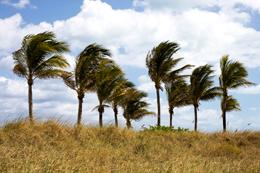http://www.nature.com/news/2010/101017/full/news.2010.543.html
Why winds are slowing
Afforestation and climate change are blamed for stilling surface winds in the Northern Hemisphere.
Joseph Milton

Wind speeds have slowed over three decades across the Northern Hemisphere.Jim Lopes / iStockphoto
Increasing amounts of vegetation could be causing up to 60% of a slowing in wind speed across the Northern Hemisphere, according to researchers analysing three decades of wind-speed data in Nature Geoscience1 today.
The decline is a potential concern for wind-turbine efficiency. But researchers cannot tell whether the effect, an average 10% slowdown, will make much difference to wind turbines — the slowing winds measured are at 10 metres above the ground, whereas turbines operate at 50–100 metres up, where there is little global data.
Several previous regional studies looking at the United States, Australia, China and parts of Europe have shown decreasing wind speeds just above the planet's surface. Climate change, afforestation and urban development had been mooted as possible causes. But, says Robert Vautard, at the University of Versailles Saint Quentin in Yvelines, France, "people always said the data were rubbish. There was no quality-controlled global archive of data."
Vautard and his colleagues collected data from about 10,000 weather stations, although they removed all but 822 stations from their list because of incomplete records. That left records stretching back to 1979, taking in Europe, central Asia, eastern Asia and North America.
Vautard had expected a study spanning such a large area to show speeds increasing in some areas and decreasing in others. But, he says, "we were surprised to see a very clear trend across the whole Northern Hemisphere". Annual wind speeds had declined at 73% of the stations, dropping by 5–15% over almost all of the land areas examined. The most pronounced effect was seen across Eurasia. The researchers also found that stronger winds have been affected more than weak ones.
Brian Golding, director of forecasting research at the UK Met Office in Exeter, Devon, says that the observation is interesting. "However," he adds, "the timescales are very short for a meteorological trend — it's entirely possible that the previous 30 years would show a different trend."
Vautard counters that the few available records dating back to 1959 suggest that the trend had been developing since the 1960s.
Hot air and greenery
Changing patterns of atmospheric circulation at high altitudes have previously been blamed for slowing wind speeds — as air temperatures and pressures in different parts of the atmosphere shift with a gradually heating Earth. But Vautard and his team say that only 10–50% of the change they observed could be explained by current understanding of how changes in high-altitude circulation affect surface wind speeds.
Another factor that has been suggested is thriving vegetation. More abundant and taller plants increase the 'surface roughness' of the ground, absorbing some of the wind's energy and slowing it down. Surface roughness is a factor in climate models used by weather predictors such as the Met Office, but it had not been thought to effect wind speed over such a wide area.
Increased vegetation — resulting from ex-agricultural land becoming overgrown, afforestation and changing landscape-management practices — could account for 25–60% of the observed stilling in wind speed, says Vautard. The researchers used satellite images to estimate increases in the volume and height of vegetation, and computer climate models to see how this would affect wind speed. "We need further investigation of whether afforestation affects wind speeds," he says, "but it's almost certainly having an effect."
Not the final answer
Vegetation changes did not wholly explain wind-speed changes seen in eastern Europe and China. In central Asia the height of vegetation would have to have tripled to account for the stilling. Vautard admits this is "fairly unrealistic". He suspects that changes in general atmospheric circulation may be more important in these parts of the world than in others.
Golding says that changes in vegetation could explain the drop, but adds that increases in urban density, which would also absorb wind energy and increase surface roughness, could be having a similar effect.
Vautard admits that urbanization could be an important factor, but says he and his team were unable to investigate its effects, because estimates to plug into computer models of how buildings affect surface roughness are not available.
As for any effect on power generation, Vautard plans to study trends in wind speed at the height of turbines. "It's not a problem for wind generation at the moment," he says, "but it could be in the future if the trend continues."
- Vautard, R., Cattiaux, J., Yiou, P., Thépaut, J.-N. & Ciais, P. Nature Geosci. advance online publication doi:10.1038/NGEO979 (2010).
__._,_.___
Comments (0)
You don't have permission to comment on this page.